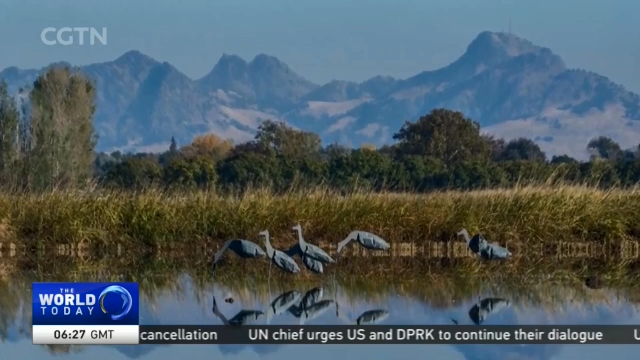
14:50, 25-May-2018
Bird B&B: Matching migratory birds with temporary wetlands
02:58

California is seeing a significant decline in shorebird populations due to the loss of its wetland. Some NGOs are trying to find out ways to save the birds. The Nature Conservancy has developed an Air B-and-B style method to accommodate these migratory birds. Mark Niu reports.
Through crowd-sourced data from millions of bird watchers and satellite images from NASA, the Nature Conservancy is using the latest tech to try to match migratory birds with water.
GREG GOLET APPLIED ECOLOGIST OF NATURE CONSERVANCY "Some can fly a thousand mile non-stop getting from point A to point B. When they land they need to have conditions that are suitable for them. To rest and refuel. And to not have enough habitat in a large stretch like we have in Central California is a real problem."
California has lost 90-percent of its wetlands over the years, contributing to a decline in shorebird populations.
But these Dunlin birds are fortunate to be resting on a pop-up wetland.
The NGO Nature Conservancy is paying rice farmers like Michael Bosworth to flood their rice fields and create a temporary place to stay.
MICHAEL BOSWORTH OPERATIONS MANAGER OF RUE & FORSMAN RANCH Mark "Gives you an extra income stream in a way."
Michael Bosworth, Operations Manager, "Yeah, so it will cover your cost and then also cover the risk you are taking. So yeah there's another income stream into the farming operation."
MARK NIU PLUMAS LAKE "After four to six weeks and tens of thousands of birds having visited a wetland like this, it's now time to drain the field which takes about 2 to 3 days. But the farmer did take a risk because now he has to plant his rice crop several weeks late."
That means a greater risk of the rainy season damaging the rice crop before it's harvested.
That's why Nature Conservancy actually holds what it calls a reverse auction for farmers.
MARJ REYNOLDS LEAD SCIENTIST OF THE NATURE CONSERVANCY "The conservation organization is the buyer. And we want to source habitat from multiple sellers and so if they want us to buy their habitat, they compete with others to drive the cost down. And our goal is to get the highest quality habitat for the use of our scarce conservation dollars."
Reynolds says these reverse auctions have reduced habitat costs by 20-percent.
In three years' time, they've taken 500 bids leading to about 22 hectares of pop-up wetlands.
PAUL SPRAYCAR PROJECT DIRECTOR OF THE NATURE CONSERVANCY "We're always trying to meet the needs of nature and people. And so very often that's going to mean sharing land resources, sharing water resources, finding ways to meet multiple needs with the same drops of water and the same parcels of land."
The Nature Conservancy is also using this same Airbnb-style concept to pay farmers to create temporary flooded environments for Sandhill Cranes.
"Rent, don't buy" now applies to more than just people including all visitors that just need a place to stay for a while.
Mark Niu, CGTN, Plumas Lake, California.

SITEMAP
Copyright © 2018 CGTN. Beijing ICP prepared NO.16065310-3
Copyright © 2018 CGTN. Beijing ICP prepared NO.16065310-3